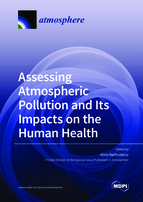Assessing Atmospheric Pollution and Its Impacts on the Human Health
A special issue of Atmosphere (ISSN 2073-4433). This special issue belongs to the section "Air Quality and Human Health".
Deadline for manuscript submissions: closed (1 December 2021) | Viewed by 24843
Special Issue Editor
Interests: hydrology; time series analysis; applied statistics; mathematical modeling
Special Issues, Collections and Topics in MDPI journals
Special Issue Information
Dear Colleagues,
Nowadays, atmospheric pollution is one of the main threats to the environment and human health. Under conditions of urbanization and industrial expansion, the reduction of pollution is an important direction to be followed by governments and populations worldwide. This issue will focus on new techniques for estimating, modeling, and forecasting atmospheric pollution and its impacts on human health. We invite authors to submit original research papers and review articles with the following topics:
- Estimating air quality using statistical and artificial intelligence methods;
- Monitoring and forecasting of pollution dynamics at local and regional scales using statistical, geostatistical, and artificial intelligence methods;
- Emphazing the impacts of atmospheric pollution on human health;
- Proposing new tools and indicators for assessing air quality;
- Assessing the pollution risk to human health using statistical methods;
- Related topics.
Prof. Dr. Alina Barbulescu
Guest Editor
Manuscript Submission Information
Manuscripts should be submitted online at www.mdpi.com by registering and logging in to this website. Once you are registered, click here to go to the submission form. Manuscripts can be submitted until the deadline. All submissions that pass pre-check are peer-reviewed. Accepted papers will be published continuously in the journal (as soon as accepted) and will be listed together on the special issue website. Research articles, review articles as well as short communications are invited. For planned papers, a title and short abstract (about 100 words) can be sent to the Editorial Office for announcement on this website.
Submitted manuscripts should not have been published previously, nor be under consideration for publication elsewhere (except conference proceedings papers). All manuscripts are thoroughly refereed through a single-blind peer-review process. A guide for authors and other relevant information for submission of manuscripts is available on the Instructions for Authors page. Atmosphere is an international peer-reviewed open access monthly journal published by MDPI.
Please visit the Instructions for Authors page before submitting a manuscript. The Article Processing Charge (APC) for publication in this open access journal is 2400 CHF (Swiss Francs). Submitted papers should be well formatted and use good English. Authors may use MDPI's English editing service prior to publication or during author revisions.
Keywords
- Air quality
- Risk assessment
- Spatiotemporal variation
- Statistical methods
- Artificial intelligence methods
- Health risk






